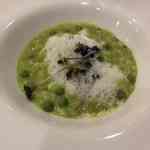I approach everyone like an adult. And I'm very real at the end. This is a business. But I want to make sure people are happy here and I create an atmosphere of family. I just don't hire people you know all my servers have to take tests quarterly about the menu. My main goal, for anybody who walks through our doors, is for them to have the best experience that they possibly have in this industry. I like to hire future chefs people who want to be in this industry for life. And I think when you can find that in people and you can coach them your way and guide them. It shows a lot about who you are as a person.
What we covered in this episode
- Chef talks about the sexiness of flavors: first has to look good on the plate then you can mix flavor profiles together to create the sexiness of flavors. When you intertwine Asian, French, and Spanish cuisines.
- White Birch's concept is a “farm to table” restaurant using produce and ingredients from local farms.
- The restaurant location is very sentimental to him as his parents use to come here on dates in the 70s and 80s.
- It's all about challenging the consumer making them want to come back more for new dishes new excitement and new creations.
- He loves change. You can constantly create seasonal items and leaving people wanting more when they come back and they see something different.
- Sam started working as a kid at his uncle luncheonette. And fell in love with cooking.
- At 19 he went to the Art Institute in NYC for Culinary Arts program and Hospitality Management.
- He landed his first job at Eleven Madison Park in NYC.
- His mentors: Chef Craig Hopson and Chef Troy Guard
- At White Birch, they support New Jersey local farms.
- Sam wishes that other restaurants would leverage local farmers, but it takes time and passion.
- He likes to open the book “Flavor Bible” during his creative process.
- Sam is a seasonal Chef.
- Chef explains his Pork Belly and his Onion Tart recipes.
- Pasta machine and Vitamix are his two key kitchen tools.
- He has two restaurants: White Birch and Slamwich Scratch Kitchen in Madison, NJ.
- To succeed, you need to have great people supporting you. Just don't hire people. Invest in your team!
- His main goal, for anybody who walks through their doors, is for them to have the best experience that they possibly have in this industry. And he needs people to provide that.
- Their definition of Slamwich is Fine Dining on a Roll!
- Chef answers five rapid-fire questions.
Chef Sam Freund multiple recipes with cauliflower.
“Cauliflower is definitely a very versatile vegetable. Obviously a lot of people eat it raw credo style.
Make it as we do at White Birch.
Cut a real thick piece and marinate it in herbs and olive oil and grill it as a cauliflower steak.
Eat it raw.
Put it in a food processor and make cauliflower couscous and add some golden raisins, parsley, and lemon. Make it like a nice couscous salad but with cauliflower instead of the grain.
Substitute.
You can also substitute some potatoes instead of like a mashed potatoes you can do mashed cauliflower.
Obviously it makes amazing soups.
Cauliflower is great. I love it. My kids love it. Again like I said, very versatile. The whole cauliflower is obviously white. So anything, if you add a darker vegetable could change the color. If you're going to do a soup you might want to add white onion, garlic, white vegetable, some herbs, vegetable stock obviously. You could put everything in a pot and bring it to a boil. And that will give it one flavor. But if you end up roasting it in the oven that brings out even more depth to the flavor. What we like to do is a nice roasted cauliflower soup. It's like off-white. The colors… you know… not as pleasing but the flavor…Unbelievable. So chop up some onions, some garlic, sweat that in some olive oil and some herbs, roast your cauliflower in the oven. When that's done, add your vegetable stock, season to taste, blend away, heat it up on the fly.”









